- genevb's home page
- Posts
- 2025
- 2024
- 2023
- 2022
- September (1)
- 2021
- 2020
- 2019
- December (1)
- October (4)
- September (2)
- August (6)
- July (1)
- June (2)
- May (4)
- April (2)
- March (3)
- February (3)
- 2018
- 2017
- December (1)
- October (3)
- September (1)
- August (1)
- July (2)
- June (2)
- April (2)
- March (2)
- February (1)
- 2016
- November (2)
- September (1)
- August (2)
- July (1)
- June (2)
- May (2)
- April (1)
- March (5)
- February (2)
- January (1)
- 2015
- December (1)
- October (1)
- September (2)
- June (1)
- May (2)
- April (2)
- March (3)
- February (1)
- January (3)
- 2014
- December (2)
- October (2)
- September (2)
- August (3)
- July (2)
- June (2)
- May (2)
- April (9)
- March (2)
- February (2)
- January (1)
- 2013
- December (5)
- October (3)
- September (3)
- August (1)
- July (1)
- May (4)
- April (4)
- March (7)
- February (1)
- January (2)
- 2012
- December (2)
- November (6)
- October (2)
- September (3)
- August (7)
- July (2)
- June (1)
- May (3)
- April (1)
- March (2)
- February (1)
- 2011
- November (1)
- October (1)
- September (4)
- August (2)
- July (4)
- June (3)
- May (4)
- April (9)
- March (5)
- February (6)
- January (3)
- 2010
- December (3)
- November (6)
- October (3)
- September (1)
- August (5)
- July (1)
- June (4)
- May (1)
- April (2)
- March (2)
- February (4)
- January (2)
- 2009
- November (1)
- October (2)
- September (6)
- August (4)
- July (4)
- June (3)
- May (5)
- April (5)
- March (3)
- February (1)
- 2008
- 2005
- October (1)
- My blog
- Post new blog entry
- All blogs
Run8pp zerobias charge asymmetry
Using the gains files I created for Run 8 (which include more accurate readout status than the DB gain table, see Finding dead TPC regions), I processed zerobias pp data from day 55 (runs 905503[126]) to look for east/west asymmetries which might have some bearing on the observed h-/h+ issues (this proposed study was mentioned here). Note that my inclusion of pad statuses was not done with high precision. In particular, status changes in pads were ignored if not in a block of at least 8 pads along a padrow. This probably leaves some number of unaccounted pads of order a few percent or less.
What I see in the zerobias data in general is that the east and west are very similar. Shown here are the charge (measured as dE, corrected for gains and acceptance of the detector) in east (black) and west (red) versus radius and phi, followed by the ratio of east/west vs. radius (statistical error here are negligible):
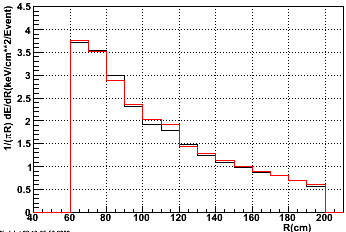
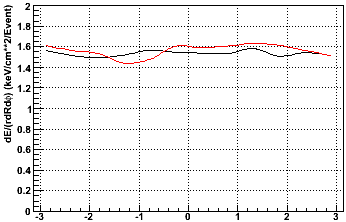

A couple things to note here:
- The east and west radial dependence is quite similar. Fitting a power low works nicely and gives r-1.65 and r-1.63 in the east and west respectively. There is some variation on the order of a few percent, but it appears that the charge shape in east and west are rather similar.
- The phi dependence makes it a little more clear that the west might have at most a few percent more charge than the east, except in the region of phi near -1.
The rest of this posting will focus on the issue of the difference near phi of -1, which further confirms that this study will likely be incapable of resolving differences of less than a few percent. But I want to get across the most important message here first:
There are no gross differences in charge loading of the east and west halves of the TPC during Run 8 pp200 data-taking, such as might be produced by backgrounds coming from one end of the TPC but not the other (perhaps blocked by the EEMC on one end, for example).
Another important note is that I have previously examined the signed DCAs in Run 8 pp data vs. luminosity as I did for the dAu data (see the first plot dAu east-west DCA asymmetry) and observe a very small asymmetry of perhaps 1% (the east side requires less correction than the west) which is consistent with the notion that the west TPC has a very small amount more charge than the east. While that calibration may be worth tuning, it is not the magnitude of the SpaceCharge correction we apply in the east vs. west which is at issue here (the idea of this particular study of zerobias data was meant to determine if the shape/model for SpaceCharge should be different for the east and west TPC): our model for SpaceCharge has an opposite (and much smaller) impact on pT of primary tracks vs. global tracks, counter to the results of analyses (nor do analyses show any luminosity dependences).
I have tracked down the issue at phi near -1 to a region of Sector 5 in the west. This region (padrows 38-40, perhaps 41) seems to have systematically low gains, as seen here in a plot of gain v. padrow and pad in Sector 5, and then averaged over all pads in each padrow (one can also see low gains on most of RDO 3, covering padrows 14-21, though padrow 21's gains seem not as low). The third plot here is the charge (from dE) measured vs. padrow in Sector 5:
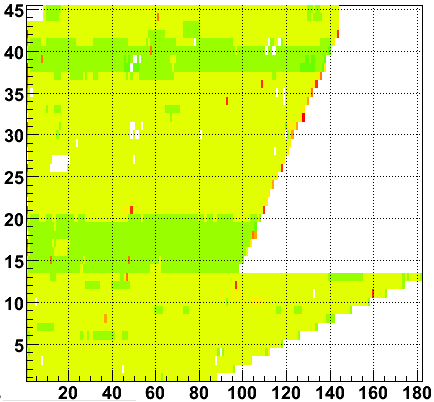
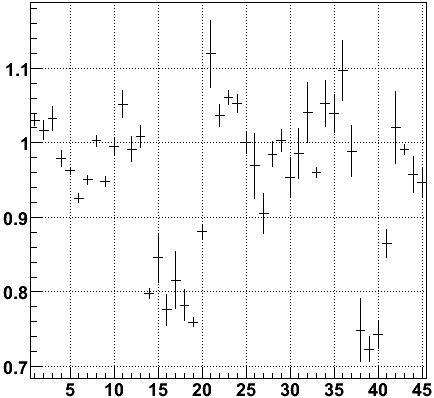
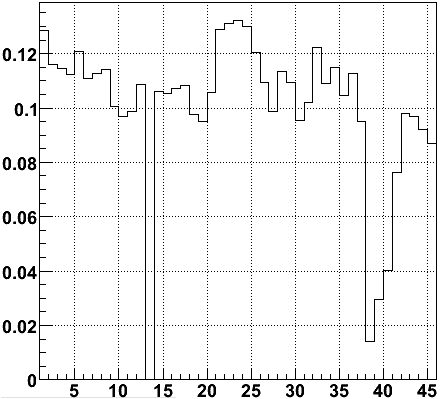
Note that despite the correction for the low gains, padrows 38-40 (and perhaps 41) are still very low. This indicates that either the cluster finder is particularly inefficient in this region (i.e. we are not finding hits), or the determined gain is far off. The latter can be answered by looking at the ADC information from before cluster-finding. This is easily obtained from the Online QA plots, and the total ADC counts in Sector 5 vs. padrow & pad, and just padrow, for run 9055030 are shown here:
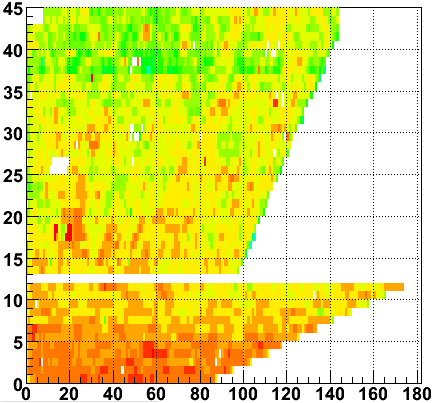
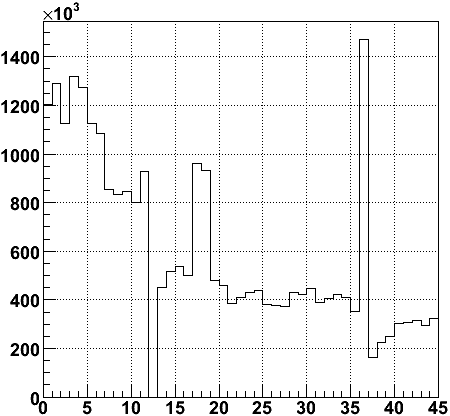
Ignoring the hot pad at padrow 37, pad 30, this ADC data seems to show that padrows 38-40 have gains which are at most a factor of ~2 lower than their neighboring padrows, confirming the gain calibration may be off a little, but not by a factor of 2. That means there must also be an inefficiency in the cluster-finder, which would be seen as a low count of hits (found clusters) in these padrows. Indeed, that is seen for these runs:
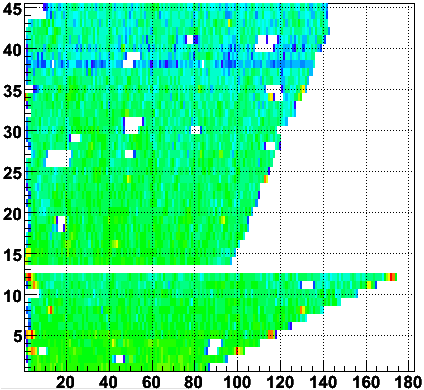
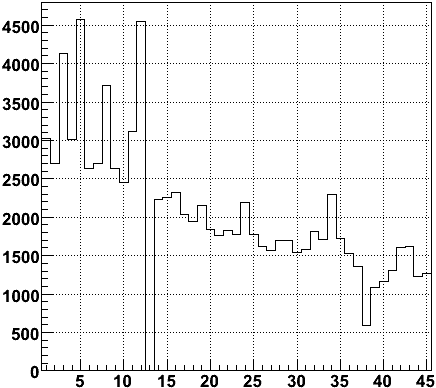
It is interesting to note that the similarly low gains on padrows 14-20 do not appear to cause any inefficiency. Neither the low cluster-finding inefficiency nor potentially high gain calibration alone explains the low charge in padrows 38-40. So it seems likely to be a combination of the two.
-Gene
- genevb's blog
- Login or register to post comments
